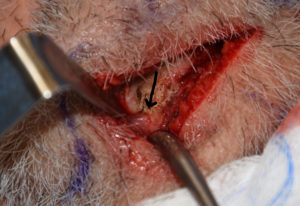Chin augmentation using an implant is the common form of aesthetic facial augmentation. Putting an implant on the front edge of the chin bone has been done for over fifty years using a variety of materials. Silicone chin implants dominate the materials used for chin augmentation and are available in a variety of styles. The extended chin implants, or an implant style that has long wings that go back along the sides of the chin into the jawline, is the basic concept of most chin implant designs today.
While chin implants are effective for increasing the horizontal projection of the chin, they are not complication free. The most common adverse aesthetic issue with their use is malposition. With the extended implant design the risk of such malpositions are magnified as it doesn’t take much less than a perfect horizontal leveling of the implant to have wing asymmetry.
The longer wings of extended chin implants requires that a complete subperiosteal elevation of the tissues is done along the lower edge of the chin. If the tissues are not adequately released the wing of the implant will not be allowed to extend back as it was designed. Because the wing of these implants is very thin it is quite easy for their tips to bend with little detection that it has happened.

The release of these mandibular ligaments is the key in chin implant placement regardless of whether it is done through a submental or intraoral approach. Failure to do can result in chin implant malposition and external asymmetries.
Dr. Barry Eppley
Indianapolis, Indiana


